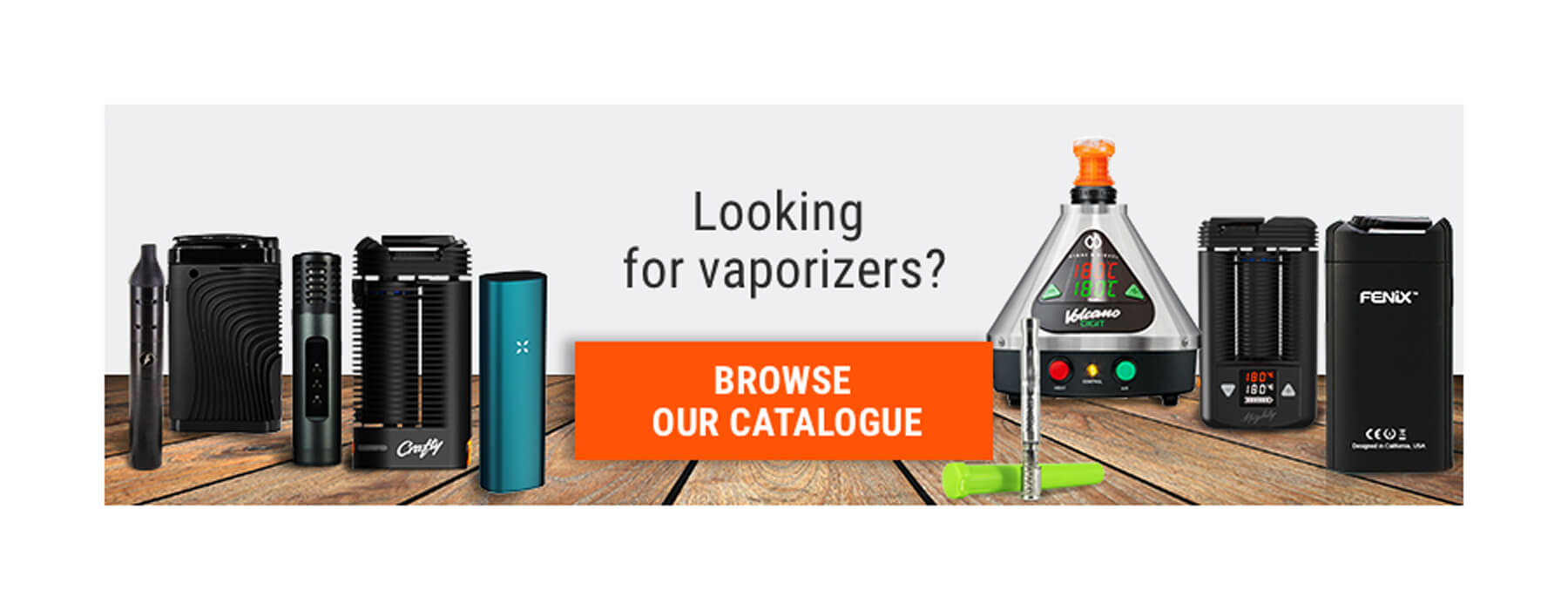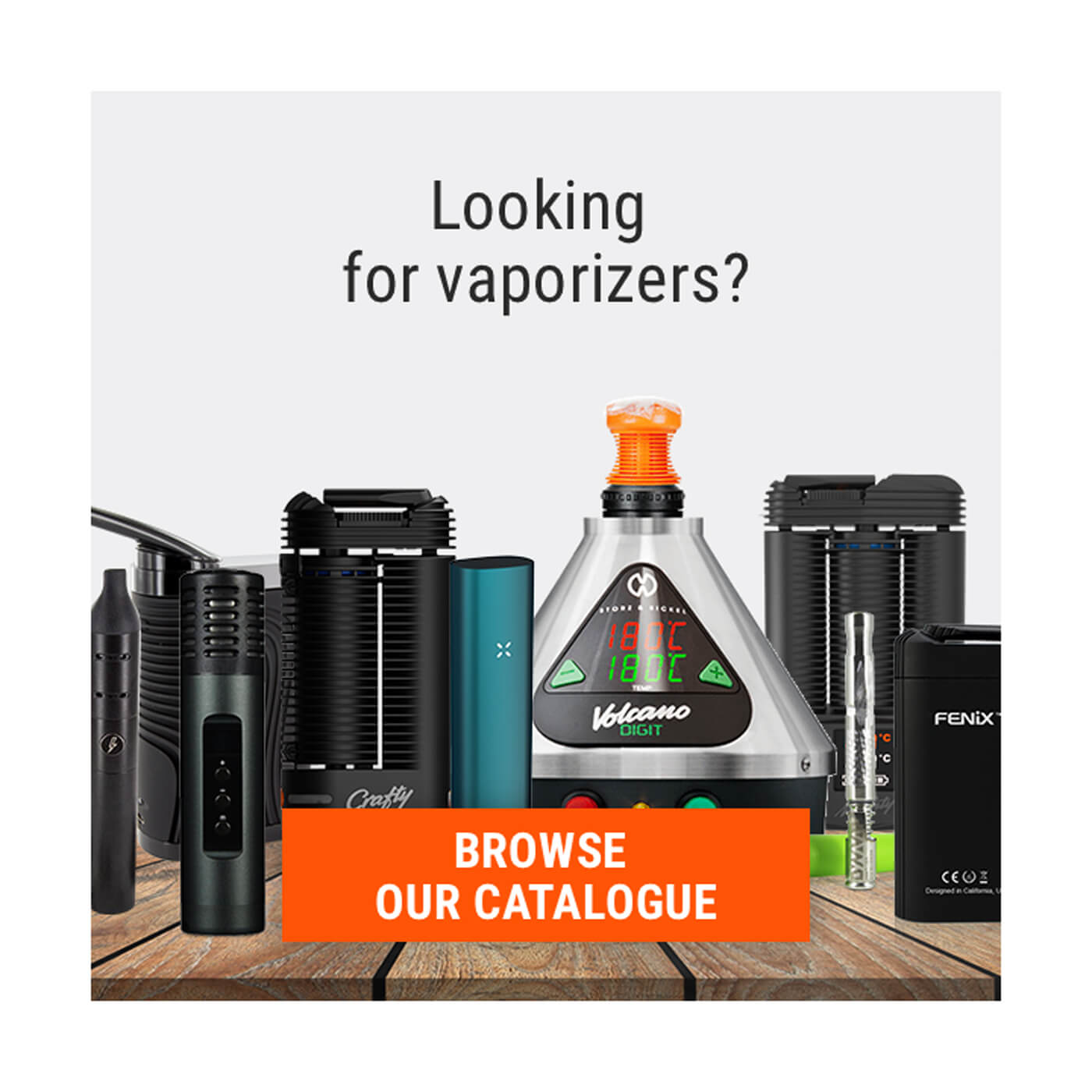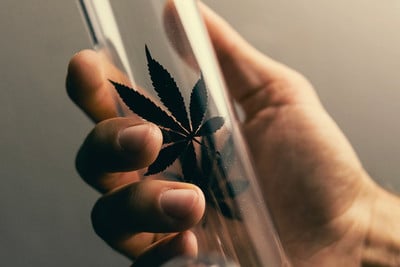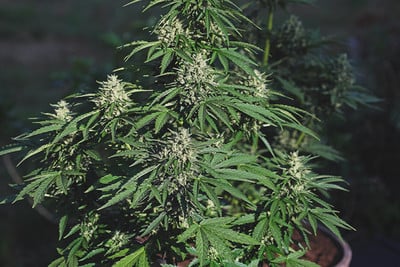.

Vaporizing vs Smoking Cannabis: What Are The Differences?
Are you still smoking cannabis? If that’s the case, read this guide on vaporizing to determine if you're ready to make the switch—just like thousands of others have. Vaporizing isn’t just considered healthier than smoking, but has many other benefits as well.
In recent years, vaporizing (vaping) has become very popular. Although research on vaping and its long-term health effects is ongoing, vaping is generally believed to be a safer and healthier alternative to smoking. As many people have already made the switch from cigarettes to vaping e-liquids, vaping is now also becoming popular among cannabis users. What is vaporizing, and how is it different from smoking? What are the benefits, and is it really that safe?
Contents:
What is vaporizing?
The big difference between vaporizing and smoking is that vaporizing doesn’t burn your weed, but merely heats it to a certain temperature. The heat ultimately activates the cannabinoids and terpenes in cannabis, releasing them into a vapor that can then be inhaled. Since you’re not inhaling smoke as you would with a joint or spliff, vaporizing sustains some practical health advantages over smoking.
Let’s take a closer look at the benefits of vaping.
The benefits of vaporizing
-
It is (likely) healthier than smoking
While the word is still out on whether vaping is really 100% safe, it is widely thought to be much safer than smoking. The reason for this is that almost all of the harmful substances that you get from smoking are produced by the combustion process, no matter if you’re burning weed or tobacco. As vaping doesn’t combust your weed, there is no smoke, and therefore far fewer toxins and free radicals than what you inhale from your jay.
Tobacco smoke certainly contains high levels of carcinogens (chemicals that cause cancer), which is why it has amassed such infamy over the years. But unfortunately, it’s likely that the smoke from cannabis might also contain these compounds, albeit potentially in smaller amounts. Moreover, smoke is known to contain tar and cause issues in the lungs, making this method of cannabis intake extremely unsuitable for those with conditions related to lung health. In a study performed on marijuana smoking, the American Lung Association found that weed smoke may release even more tar[1] into the body as compared to tobacco smoking. This primarily comes down to the fact that cannabis smokers normally inhale deeper and longer than cigarette smokers.
By switching to vaping, your lungs are immediately at a much lower threat of adverse outcomes. A 2007 study published in the Harm Reduction Journal found that vaporizing cannabis can reduce respiratory problems[2] that can otherwise be caused by smoking marijuana.
The health risks associated with smoking are enough in themselves to convince many individuals to switch to vaping. But aside from the long-term outcomes, many simply find vaping to be a smoother, less dirty, and more enjoyable experience for the body in the short-term. Just make sure you regularly clean your vape.
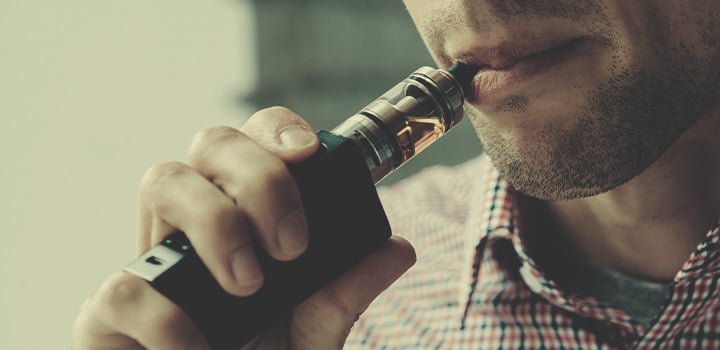
-
Vaping is more efficient and maximises potency, bioavailability
The active compounds in cannabis are very sensitive. By administering cannabinoids, terpenes, etc. into the body via smoke, you burn off more than half of these compounds before you even take a full puff from your joint. You lose another 15–20% of the good stuff as your bud burns between draws. This makes smoking cannabis extremely inefficient.
Since the temperatures involved with vaporizing are much lower, and often much more specific, the active compounds are not only preserved, but utilised to their full potential. As a result, your cannabis vapor will be purer and more potent—and you will not be wasting as much of your bud. Hence, vaping will also help save you money over time.

-
You can enjoy more flavours
In addition to the cannabinoids that give weed its potency, cannabis also contains aromatic compounds called terpenes that give it its flavour. These compounds are also very volatile and sensitive to heat, so excessive temperatures during combustion can swiftly destroy them. On the contrary, vaping can actually help optimise the experience of individual terpenes. What’s interesting to know is that some terpenes have different boiling points, so they are released into vapor at certain, lower temperatures.
For example, beta-caryophyllene, a terpene with a spicy and peppery aroma, is released at low temperatures of around 118°C—and it doesn’t like to go much higher than that. Then there are other terpenes, such as linalool, that can withstand higher temperatures.
When vaping, you can normally adjust the temperature of your device to some degree, allowing you to fine-tune the experience. This way, you can enjoy the full range of flavour and aroma nuances that you cannot get when smoking cannabis.
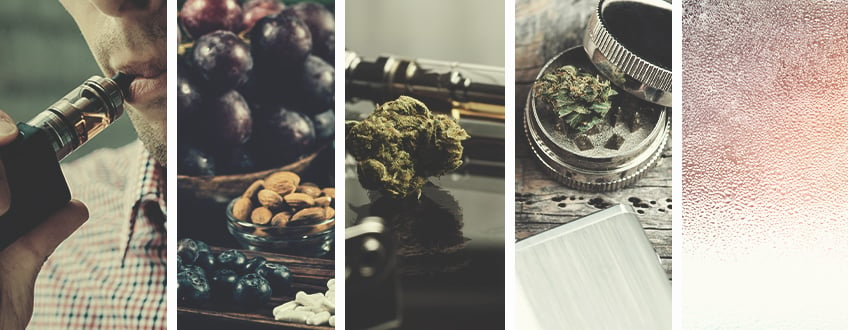
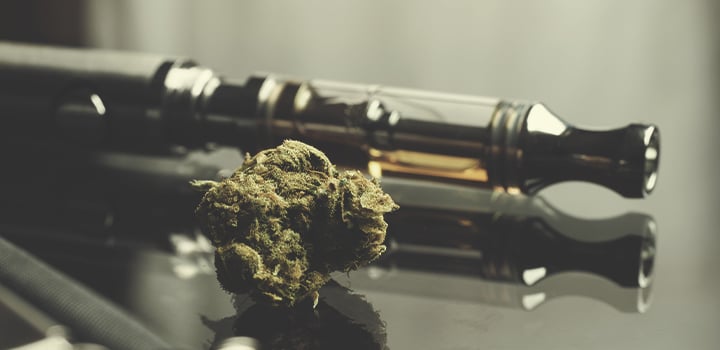
-
You can customise your high
In the same way you can influence the flavour of your weed with different temperature settings, you can also adjust the intensity of your high. More of the cannabinoids in your weed are released when you vape at higher temperatures, making for a more potent and faster-hitting effect. If you want a mellow high, set your vaporizer to a low temperature of about 150°C. For a somewhat stronger effect, adjust the temperature to a medium temperature of 166–187°C. If you want maximum potency out of your weed, set your vape to the highest temperature setting. However, you should not go over 229°C since this is already near combustion temperature, where the potency and flavour of your weed will diminish.
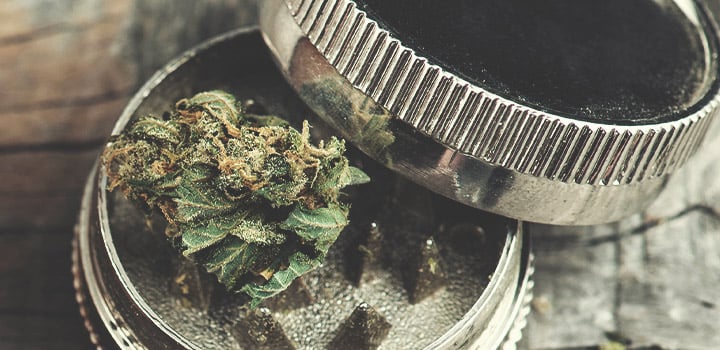
-
Why temperatures matter when vaporizing cannabis
A scientific study from 2009 looked closer into the effects of vaporizing at different temperatures. For the study[3], researchers vaped cannabis at three different temperatures: 170°C, 200°C, and 230°C, measuring the cannabinoid-to-byproduct ratio (in other words the purity) of vapor at these temperatures.
It was found that even at higher temperature settings, the vapor contained significantly fewer harmful toxins than smoke. The study also found that most of the therapeutic cannabinoids, such as cannabichromene (CBC), are released into vapor just below the combustion temperature of 232°C.
On the other hand, your own personal preferences may vary. If you want the most flavour, or if you prefer a less strong high, you may choose to vape at lower temperatures instead. So if you want to start vaping, make sure that you choose a vaporizer that allows temperature adjustment. This way, you can take full advantage of all of the benefits that vaporizing can offer you.
Vape High vs Smoke High
Besides offering a cleaner, healthier smoke, another reason vaporizers have become so popular recently is because of the notably different high they produce. And, while every person’s experience with cannabis is unique, most people who have tried vaping agree that it produces a “clearer high” than smoking cannabis from a pipe or joint.
Given our own personal experiences, and those of other cannabis users, here are some of the biggest differences between the highs of vaporized and smoked cannabis:
Vape High
- Less cognitively impairing.
- More functional: A lot of people report they have an easier time focusing on tasks or staying productive after vaping cannabis when compared to smoking.
- More uplifting: Some people find that vaporizer highs tend to be more uplifting and energetic.

Smoke High
- More cognitively impairing: Some people find that smoking cannabis gives them more “brain fog” than vaporizing.
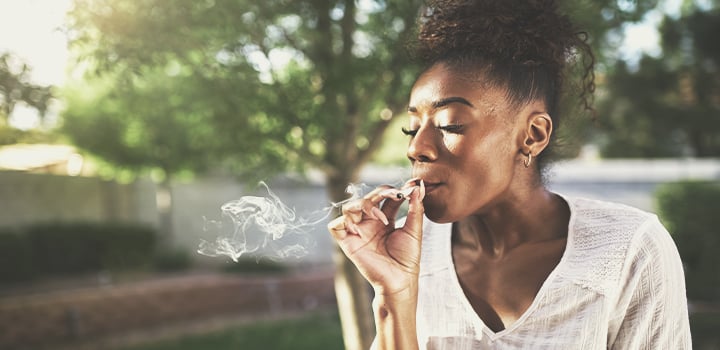
- More relaxing or sleepy stone: You may find that smoking cannabis produces a more relaxed, couch-locking high.
Keep in mind that the biggest impact on your high is the chemical profile of the strain you’re consuming. However, the fact that vaporizing doesn’t combust your concentrates or flower suggests it might produce a cleaner, clearer high.

What research says about vaporizing cannabis
Fortunately, cannabis consumption isn’t much of a taboo subject anymore. Many individuals now consume cannabis for strictly medical purposes, and even recreational use is more often tolerated, if not entirely legal. This slow but sure relaxation of cannabis laws not only benefits the end consumer, but opens up research opportunities in the field, not to mention a lucrative industry. With the obvious advantages of vaping over smoking, science is honing in on the specific outcomes of vaporizing cannabis as a method of consumption for medicinal users.
In a 2015 study[4], 2,910 cannabis users of different ages (18–90) were asked about cannabis use and vaporizing. 61% of participants in the study reported having used a vaporizer at some point in their lives, 37% reported vaping in the past 30 days, while 20% reported vaping more than 100 days in their lifetime. 12% endorsed vaping as their preferred method. The study found that those who vaped reported it to be “healthier, better tasting, produced better effects, and more satisfying”. On the other hand, only a small percentage (14%) of cannabis vapers stopped smoking altogether.
A 2016 study[5] sought to examine intake preferences in cancer patients using cannabis to alleviate symptoms. They found vaporizing to be the third most preferred method of consumption, after tablets and mouth sprays. Another 2015[6] study measured blood levels and confirmed previous studies about the effectiveness of vaporizing as a delivery route for THC.
Vaporizers and Safety: Are Vaporizers Safe?
In 2019, vaping became a massive public health concern. Between August and September, the US saw a sudden increase in hospitalisations related to the use of e-cigarettes and vaporizers. By February 2020[7], the US Centres for Disease Control reported around 2,800 hospitalisations and/or deaths related to E-cigarette or Vaping Associated Lung Injury (EVALI).
According to Dr Lynn D’Andrea, a pediatric pulmonologist at the Children’s Hospital of Wisconsin, some of the most alarming symptoms of vaporizer-related lung injury[8] include extremely fast, laboured breathing, weight loss, chest pain, and coughing. CT scans of patients' lungs also often showed a strange, diffused “ground glass” pattern.
The biggest culprit behind 2019’s EVALI outbreak is believed to be vitamin E acetate, a thickening agent sometimes used in the production of THC vape cartridges and “vape juice”, especially those obtained from “informal sources” like online dealers. The CDC found[9] vitamin E acetate present in over 50% of samples of e-cigarettes/vape liquids tested from different states, as well as lung fluid samples from people with EVALI.

Luckily, according to national data, EVALI cases have shown a steady decline since mid-September 2019. The CDC suggests a number of reasons why:
- Increased awareness of the potential dangers related to vaping
- Law enforcement targeting the sale of illicit vape products
- The removal of vitamin E acetate from vape products
Of course, the EVALI outbreak sent up a ton of red flags around the safety of vaping, and for good reason. It’s also sparked a lot of debate around whether vaping is really as safe of a smoking alternative as it's made out to be.
In general, we’re firm believers that vaporizing cannabis can be a healthier alternative to smoking. However, we also acknowledge that vaping is fairly new; it took decades for science to clearly identify the health effects of smoking, and vaping is still in its early days.
We also believe that it might be safer to vaporize cannabis flower rather than concentrates or e-liquids, as these products may contain trace amounts of chemical solvents or other products that could be harmful when heated and inhaled. However, we won’t know any of this for sure until more comprehensive research is done on vaping.
Other Potential Health Risks of Vaping
Besides EVALI, there are other health concerns about vaping. The US Food and Drug Administration, for example, has raised concerns about e-cigarettes exploding due to battery issues. These explosions have caused severe injuries[10] and even proven fatal[11]. Research in the journal Tobacco Control[12] reports over 2,000 ER visits due to e-cigarette explosion and burn injuries between 2015 and 2017.
Besides these explosions, the FDA has also investigated a possible link between vaping and seizures[13], possibly due to nicotine poisoning (which has been shown to cause seizures in the past). However, there’s not a lot of data on this topic, and it’ll be some time before we can confidently say whether or not there’s a link between vaping/e-cigarettes and seizures.
What About Vaping CBD?
The EVALI crisis seems to be caused by vitamin E acetate, which the CDC suggests to be more present in cannabis vape products containing THC. However, this doesn’t rule out the possibility of finding vitamin E acetate in other vape products, including nicotine vape juice or CBD cartridges.

Vaping CBD Flower vs CBD Concentrates
If you’re worried about the health risks of vaping mentioned in this article, we always recommend vaping flower over concentrates, especially if you live in an area where vape products aren’t heavily regulated. Cannabis oils and vape juices are manufactured using solvents and other compounds, and while there are plenty of great manufacturers producing clean products, subpar products may contain trace compounds that pose potential health risks.
If you do want to vape CBD concentrates, make sure you only use products that come with the guarantee of a company/manufacturer you trust.
Types of CBD Vape Oil: Vape Juice/Oil vs Dabs vs Cartridges
There are three main types of CBD vape oil currently on the market:
- Vape oil (or vape “juice”): This liquid is used to fill cartridges or refillable vaporizers. Vape juice comes in different flavours and contains varying amounts of CBD.
- CBD cartridges: These are pre-filled, single-use devices designed to be used with vape pens. Depending on where you live, you might have access to a wide variety of CBD cartridges with unique terpene profiles, cannabinoid contents, and more.
- CBD extracts (dabs): Shatter, wax, and crumble are just some of the names given to CBD extracts. These products are made by extracting CBD and other cannabinoids from different types of cannabis plants. These products are designed to be used with concentrate-friendly vaporizers or dab rigs.
What About Full-Spectrum, Broad-Spectrum, and CBD Isolate?
CBD products are usually categorised as full-spectrum, broad-spectrum, or isolate. Here’s what these terms mean:
- Full-spectrum CBD extracts contain all of the crucial compounds that occur naturally in the cannabis plant. This includes other cannabinoids (including trace amounts of THC), terpenes, and more.
- Broad-spectrum CBD products are the same as full-spectrum, save for one major difference—broad-spectrum extracts are completely stripped of any and all THC.
- CBD isolates, as the name suggests, contain just isolated CBD, making this the purest type of extract.
In general, we always recommend full-spectrum products as they provide all the benefits the cannabis plant has to offer. However, if you’re susceptible to random drug tests, you may want to look into broad-spectrum or isolate products to avoid a positive reading. Unfortunately, even trace amounts of THC can, in some cases, set off a drug test.
What’s the Difference Between CBD Vape Juice and CBD Oil/Tinctures?
CBD vape juice is designed to be vaporized and inhaled into the lungs. Here, the active compounds enter the bloodstream via the alveoli and take effect in as little as 5–10 minutes. However, the effects of vaporized CBD also tend to wear off relatively fast.
CBD oils/tinctures, on the other hand, are designed to be taken sublingually or orally. Here, the compounds in the oil are absorbed by the mucous membranes under the tongue and in the cheek, or by the digestive system (if you swallow the oil). CBD oils tend to take effect within 20 minutes (even longer if swallowed). However, swallowed CBD also has a slower, more steady release that can be very beneficial for those seeking longer-lasting effects.
Unfortunately, studies have shown that the bioavailability of orally administered CBD[14] is relatively poor, meaning you may need to take more of an oral tincture to achieve a desired effect than you would with vape juice. That being said, bioavailability is not the only factor influencing the effectiveness of CBD.
It’s important to note that CBD oil meant for sublingual or oral consumption is most often not suitable for vaporizing. The carrier oils present in these formulas are not meant to be heated and inhaled.
Vaporizing vs. Smoking cannabis: the bottom line
At Royal Queen Seeds, you can find a range of vaporizers for all budgets, from easy-to-use and affordable vape pens, such as the Storm Vaporizer Pen, to advanced, high-end desktop vaporizers like the renowned Volcano Hybrid.
Consider vaporizing cannabis if you want the healthiest, purest, most flavourful, and most potent cannabis experience!
- Marijuana and Lung Health | American Lung Association https://www.lung.org
- Decreased respiratory symptoms in cannabis users who vaporize | Harm Reduction Journal | Full Text https://harmreductionjournal.biomedcentral.com
- Cannabis smoke condensate III: the cannabinoid content of vaporised Cannabis sativa - PubMed https://www.ncbi.nlm.nih.gov
- Online Survey Characterizing Vaporizer Use among Cannabis Users https://www.ncbi.nlm.nih.gov
- Clinical trials of medicinal cannabis for appetite-related symptoms from advanced cancer: a survey of preferences, attitudes and beliefs among patients willing to consider participation - PubMed https://www.ncbi.nlm.nih.gov
- Controlled Cannabis Vaporizer Administration: Blood and Plasma Cannabinoids with and without Alcohol - PubMed https://www.ncbi.nlm.nih.gov
- Outbreak of Lung Injury Associated with the Use of E-Cigarette, or Vaping, Products | Electronic Cigarettes | Smoking & Tobacco Use | CDC https://www.cdc.gov
- How Vaping Became a Public Health Crisis https://nymag.com
- Outbreak of Lung Injury Associated with the Use of E-Cigarette, or Vaping, Products | Electronic Cigarettes | Smoking & Tobacco Use | CDC https://www.cdc.gov
- Vape pen explodes, shattering teen's jaw amid rising concerns over batteries https://www.nbcnews.com
- Deadly vape explosion highlights safety gaps - The Verge https://www.theverge.com
- Electronic cigarette explosion and burn injuries, US Emergency Departments 2015–2017 https://tobaccocontrol.bmj.com
- Some E-cigarette Users Are Having Seizures, Most Reports Involving Youth and Young Adults | FDA https://www.fda.gov
- What is CBD Bioavailability (and Why Should You Care?) | CBD Awareness Project https://www.cbdoil.org


























